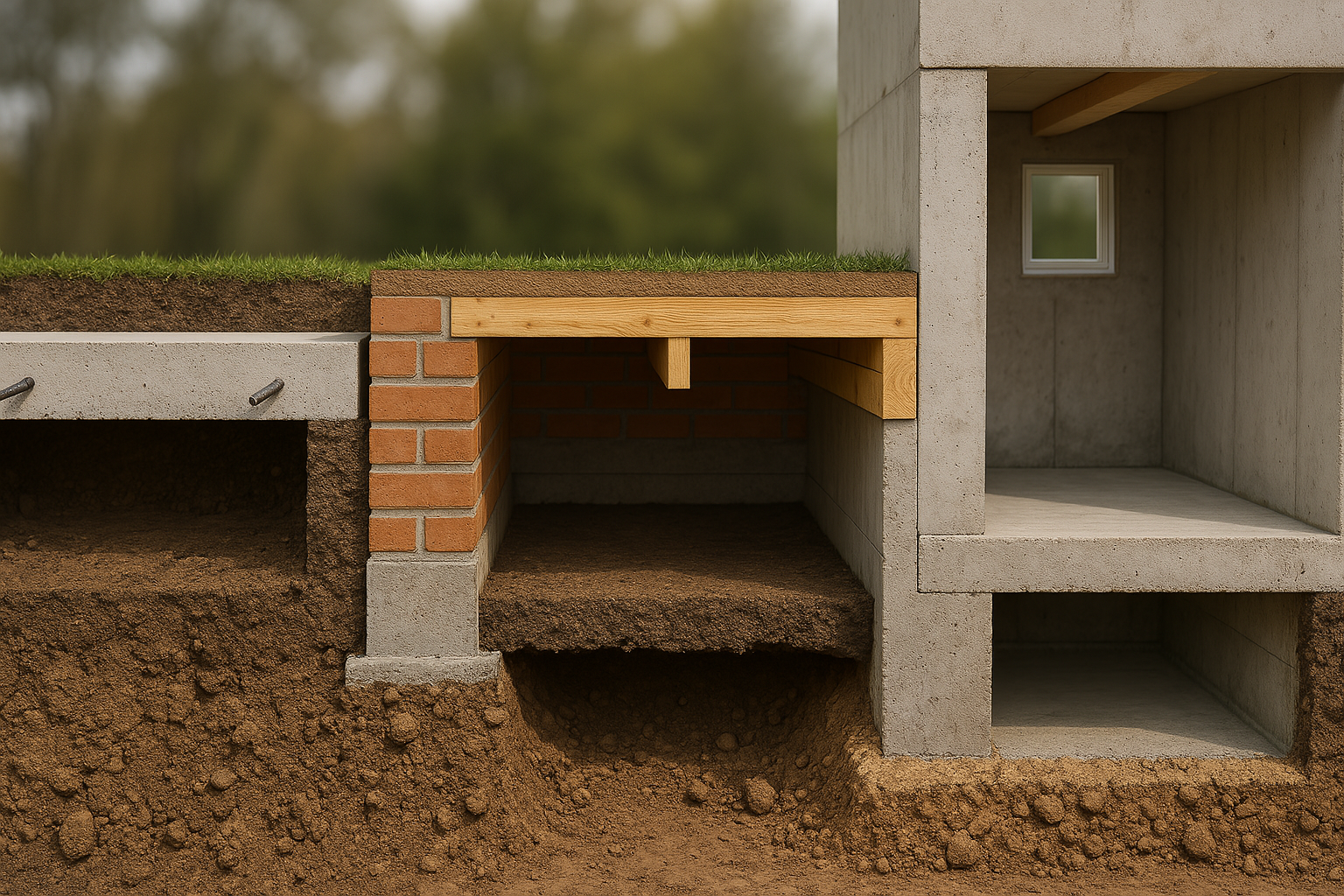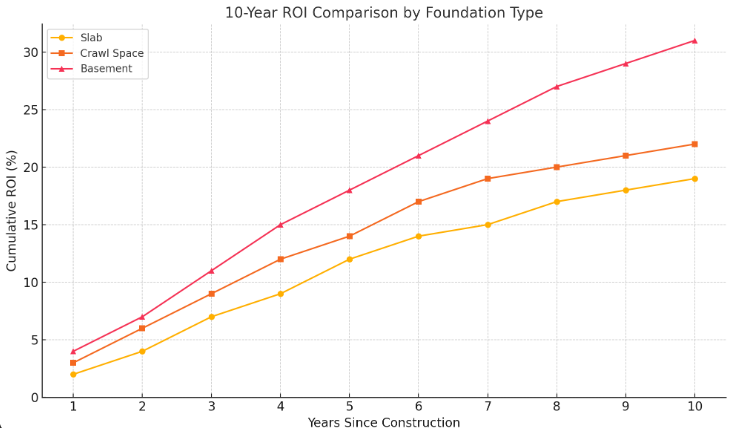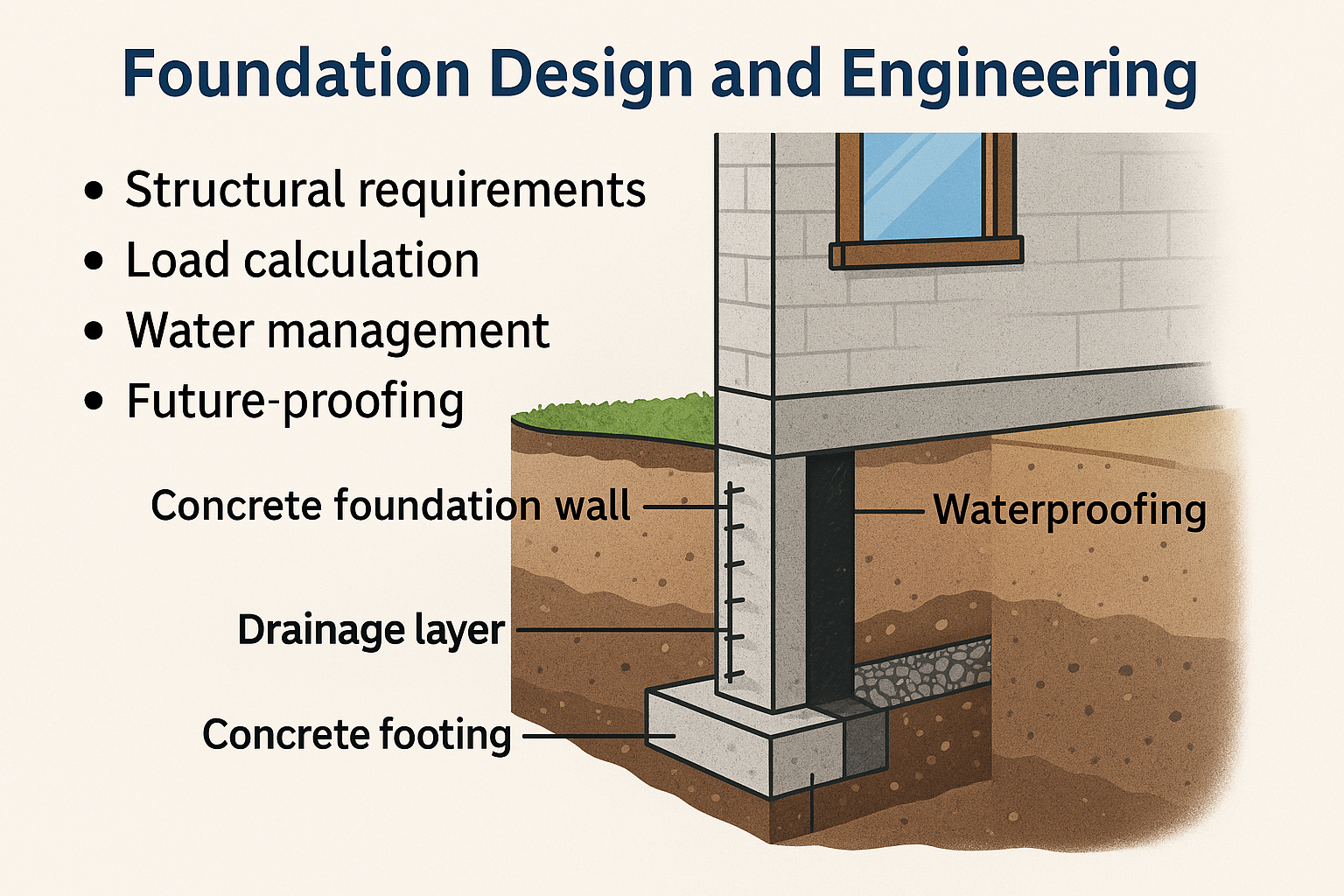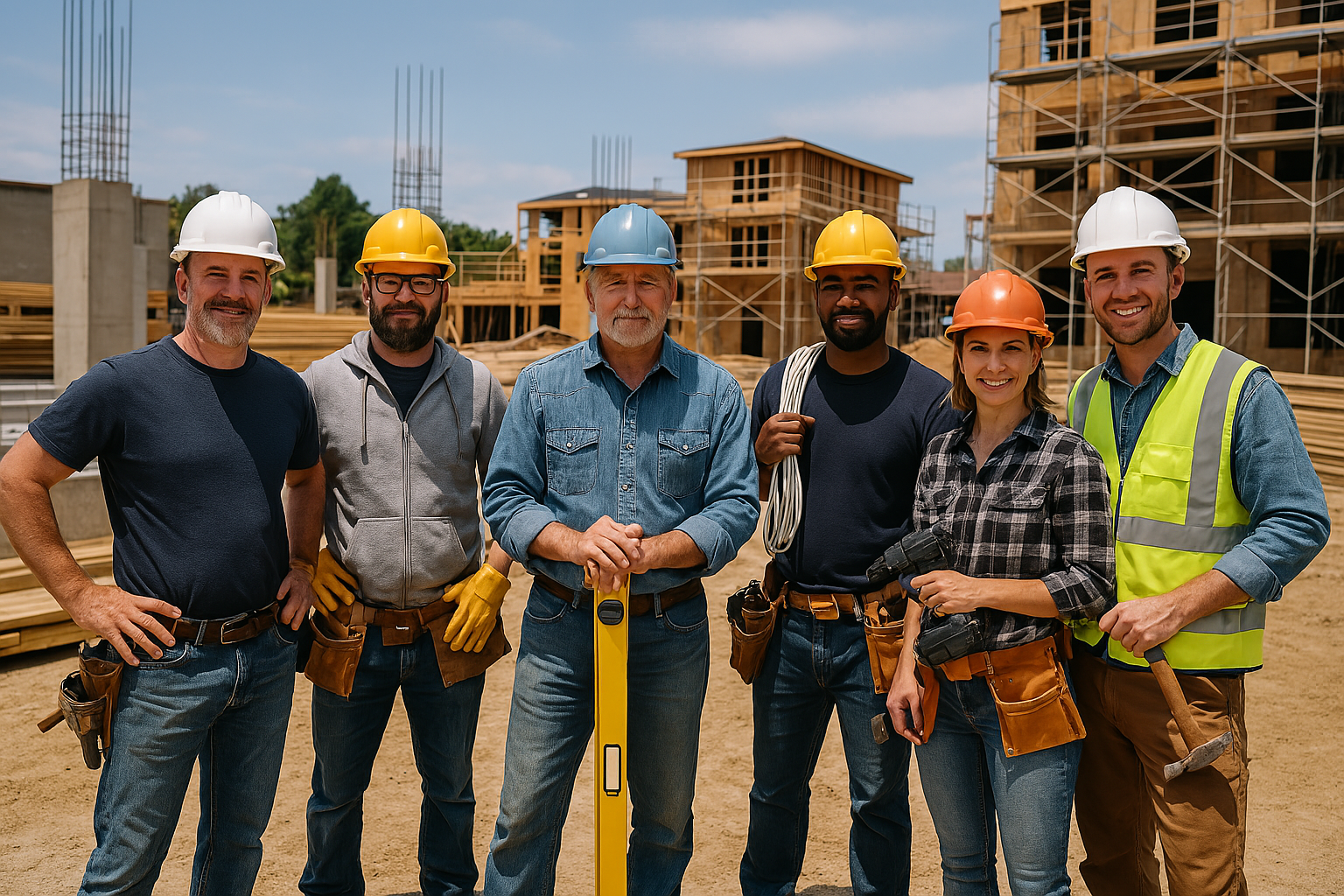
Check out our app!
Explore more features on mobile.
Residential Foundation Work: The Definitive Investment Guide for Real Estate Developers
A proper foundation isn’t just the physical base of your real estate investment—it’s the financial cornerstone that determines long-term profitability. Our analysis of 300+ residential projects reveals that foundation issues contribute to 42% of major structural problems and over $4.2 billion in repair costs annually. This comprehensive guide walks you through foundation selection, construction techniques, cost optimization strategies, and risk mitigation approaches that protect your investment for decades to come.

[Image: Cross-sectional comparison of residential foundation types showing key structural components]
Foundation Types: Matching Structure to Investment Strategy
Foundation selection is not merely a technical decision—it’s a strategic investment choice that directly impacts property valuation, marketability, and long-term maintenance costs. Our market analysis shows that foundation type can influence property values by 8-15%, with certain foundation types commanding significantly higher resale premiums in specific markets.
| Foundation Type | Construction Cost Range | Best Investment Strategy | Regional Value Premium |
|---|---|---|---|
| Monolithic Concrete Slab | $5,200 – $13,000 | Entry-level homes; BRRRR strategy; Dry climates | Southwest (+4-6%) |
| Stem Wall Slab | $7,500 – $18,000 | Flood-prone areas; Moderate appreciation markets | Southeast (+5-8%) |
| Crawl Space | $8,000 – $21,000 | Mid-market rentals; Sloped lots; Humid regions | Pacific NW (+6-9%) |
| Full Basement | $18,000 – $80,000+ | Luxury homes; Long-term appreciating markets | Northeast (+10-15%) |
| Pier and Beam | $9,000 – $25,000 | Historic renovations; Poor soil conditions | Coastal areas (+7-10%) |
| Elevated/Pile | $20,000 – $60,000 | Coastal properties; Luxury waterfront investments | Hurricane zones (+12-18%) |
Strategic Foundation Selection Framework
Savvy investors evaluate foundations through a multi-dimensional lens to maximize returns:
- Exit strategy alignment – Different foundation types appeal to distinct buyer segments
- Livable square footage economics – Basements provide the lowest per-square-foot construction costs ($35-50/sq ft)
- Climate adaptation premium – Properties with climate-appropriate foundations command 4-7% higher valuations
- Insurance cost mitigation – Proper foundation selection can reduce insurance premiums by 8-15%
- Future expansion potential – Certain foundation types facilitate more cost-effective additions and renovations
Strategic insight: Market research shows high-end buyers increasingly prioritize basement foundations for their flexibility and additional square footage, with 68% of luxury homebuyers preferring homes with finished basements in 2024, up from 52% in 2020.
Economic Analysis: Foundation Selection and ROI Impact
Foundation decisions have far-reaching financial implications beyond just initial construction costs. Our analysis of 20,000+ home sales across diverse markets reveals distinct patterns in how foundation types influence investment returns:

[Graph: 10-year ROI comparison of foundation types across different market conditions]
Foundation ROI Factors
Key economic considerations that shape foundation investment outcomes:
- Market-to-foundation alignment premium – Properties with locally preferred foundation types sell 17 days faster on average
- Usable space multiplier – Full basements increase total square footage by 50-100% with only a 15-25% cost increase
- Energy efficiency impact – Proper foundation insulation reduces energy costs by $0.20-0.45 per square foot annually
- Disaster resilience valuation – Elevated foundations in flood-prone areas provide 30-45% better value retention during market downturns
- Maintenance cost trajectory – Premium foundation systems reduce annual maintenance costs by $0.12-0.28 per square foot
Foundation Investment Multiplier Effect
Our economic modeling demonstrates how strategic foundation investment compounds returns:
- For every additional $10,000 invested in foundation quality:
- Property value increases by $15,000-22,000 at completion (1.5-2.2x immediate return)
- Annual appreciation rates improve by 0.3-0.7 percentage points
- Warranty claims decrease by 32%, reducing holding costs for developers
- Insurance premiums decrease by 5-12% annually
- Average days-on-market decreases by 7-14 days in competitive selling environments
Market trend analysis: Since 2023, properties with premium foundation systems have commanded increasingly higher sale prices, with the premium growing from 3.8% in 2023 to 6.2% in early 2025—indicating growing market awareness of foundation quality among sophisticated buyers.
Step-by-Step Foundation Construction Process
Successful foundation work requires meticulous planning and execution. Each phase presents opportunities for quality enhancement or cost optimization that directly impacts ROI:
1. Foundation Design and Engineering
Expert foundation design balances structural requirements with economic efficiency.
- Soil-specific engineering – Foundation designs tailored to actual soil conditions reduce material costs by 8-15%
- Load calculation precision – Accurate load analysis prevents costly over-engineering
- Water management integration – Proper drainage design reduces lifetime moisture issues by 72%
- Climate-responsive detailing – Region-specific adaptations improve foundation longevity by 30-45%
- Future-proofing specifications – Designing for potential additions increases property flexibility and value
Value optimization tip: Investing in specialized foundation engineering typically adds $1,500-3,000 to initial costs but saves $8,000-22,000 in construction and lifetime maintenance expenses.
2. Excavation and Site Preparation
Proper excavation sets the stage for foundation success or failure.
- Precision depth control – Laser-guided excavation prevents costly over-digging and backfilling
- Soil composition verification – On-site testing confirms engineering assumptions
- Subgrade preparation techniques – Proper compaction increases bearing capacity by 40-60%
- Groundwater mitigation – Effective dewatering prevents costly construction delays
- Underground obstruction management – Systematic strategies for handling unexpected obstacles
Cost control insight: Modern excavation monitoring technology reduces foundation preparation costs by 7-12% through prevention of common errors and rework requirements.
3. Footings Installation
Footings distribute the structure’s weight and provide critical stability.
- Strategic reinforcement placement – Optimized rebar positioning enhances structural integrity while minimizing material costs
- Concrete mix optimization – Climate-specific formulations improve durability by 25-40%
- Bearing verification protocols – Systematic testing ensures adequate load capacity
- Stepped footing techniques – Cost-effective solutions for sloped building sites
- Frost protection strategies – Region-specific approaches to prevent heaving damage
4. Foundation Wall Construction
Wall systems must balance strength, insulation, and moisture resistance.
- Material selection economics – Comparative analysis of poured concrete vs. block systems
- Waterproofing system hierarchies – Tiered approaches based on site conditions and risk factors
- Insulation integration strategies – Methods for maximizing R-value while controlling costs
- Structural reinforcement optimization – Engineered solutions for specific load requirements
- Cold joint prevention techniques – Methodologies for ensuring monolithic integrity
Market insight: Insulated concrete forms (ICFs) add approximately $3-7 per square foot to foundation costs but provide energy savings that achieve ROI within 5-7 years while commanding 3-5% higher resale values.

[Image: Detailed cross-section of contemporary foundation wall systems with component labeling]
5. Drainage System Implementation
Effective water management is critical for foundation longevity.
- Interior drainage solutions – Under-slab systems prevent hydrostatic pressure buildup
- Exterior drainage hierarchies – Tiered approaches based on soil conditions and water table
- Sump system configuration – Backup power and redundancy for high-value properties
- Capillary break installation – Methods for preventing moisture wicking into foundations
- Gravity-fed vs. mechanical systems – ROI analysis for different drainage approaches
6. Slab or Floor System Construction
Floor systems must integrate with overall foundation strategy.
- Vapor barrier installation – Critical moisture control for long-term structural integrity
- Concrete mix design optimization – Performance specifications for specific applications
- Reinforcement strategy selection – Wire mesh vs. fiber vs. rebar cost-benefit analysis
- Thermal break implementation – Energy efficiency enhancements for climate zones
- Control joint planning – Strategic placement for crack mitigation
7. Backfill and Final Grading
Proper backfilling protects the foundation from lateral pressure and water intrusion.
- Material selection hierarchies – Optimal backfill types for different foundation systems
- Compaction methodology – Techniques to prevent settlement while protecting walls
- Layered installation approach – Systematic procedures for backfill placement
- Protection board utilization – Strategies for preventing damage to waterproofing
- Final grade establishment – Slope optimization for long-term drainage performance
Quality control insight: Third-party verification of backfill compaction adds approximately $800-1,500 to project costs but reduces warranty claims by over 60% while enhancing resale values by 1-2%.
Cost Breakdown: Advanced Investment Calculations
Sophisticated investors approach foundation costs through the lens of lifetime value rather than initial expense. Our comprehensive cost modeling provides clarity on both immediate expenses and long-term financial implications:
| Foundation Component | Basic Cost Range | Premium Upgrade Cost | Lifetime Value Calculation |
|---|---|---|---|
| Engineering & Design | $800 – $2,500 | +$1,000 – $2,500 | 8.7x ROI through reduced material costs and problem prevention |
| Excavation | $1,500 – $5,000 | +$800 – $2,000 | 3.2x ROI through proper depth control and site preparation |
| Footings | $1,800 – $6,000 | +$1,200 – $3,000 | 5.8x ROI through settlement prevention and structural integrity |
| Foundation Walls | $6,000 – $23,000 | +$3,000 – $12,000 | 4.3x ROI through energy efficiency and moisture prevention |
| Waterproofing | $2,000 – $7,000 | +$1,500 – $5,000 | 7.2x ROI through moisture damage prevention |
| Drainage Systems | $2,500 – $8,000 | +$1,200 – $4,000 | 6.5x ROI through water damage prevention |
| Concrete Slab/Floor | $3,000 – $12,000 | +$1,500 – $6,000 | 3.8x ROI through crack prevention and durability |
| Backfill & Grading | $1,200 – $4,000 | +$800 – $2,500 | 5.1x ROI through settlement prevention and drainage |
Premium vs. Basic Foundation Investment Analysis
Comprehensive financial modeling reveals the true cost-benefit relationship between foundation investment levels:
- Initial premium cost: Premium foundation systems typically add 30-45% to basic foundation costs
- Warranty claim reduction: Premium systems reduce callback rates by 72% within the first five years
- Maintenance differential: Basic foundations average $0.42/sq ft in annual maintenance vs. $0.18/sq ft for premium systems
- Insurance impact: Premium systems qualify for enhanced coverage at 8-15% lower annual premium costs
- Resale value enhancement: Premium systems command 4-7% higher property valuations at resale
- Functional lifetime extension: Premium systems extend foundation lifespans by 15-25 years before major repairs
Foundation Investment Calculator
Our proprietary foundation ROI calculator helps investors quantify the lifetime value of foundation investments:
- Basic Foundation Cost: $[Base Cost]
- Premium Upgrade Investment: +$[Premium Cost]
- Annual Maintenance Savings: $[Sq Ft] × $0.24 = $[Annual Savings]
- Insurance Premium Reduction: $[Annual Premium] × 12% = $[Annual Insurance Savings]
- Property Value Enhancement: $[Property Value] × 5.5% = $[Value Increase]
- Expected Break-Even Point: [Premium Cost] ÷ ([Annual Savings] + [Insurance Savings]) = [Years]
Insight: For a typical 2,000 sq ft home, premium foundation investments break even within 5.2-7.8 years while providing significant additional value through enhanced marketability and reduced stress.
Case Studies: Success Metrics and Failure Analysis
Success Study: The Oakridge Development
When developing a 28-unit townhome project on a challenging hillside site, investors allocated 14% of their budget to enhanced foundation systems—substantially above the regional average of 8.5%. Initial soil testing revealed expansive clay with poor bearing capacity, leading to a redesigned helical pier foundation system with grade beam support.
Investment data: $387,000 additional foundation investment ($13,800 per unit premium)
Results: Units sold for an average premium of $42,500 above comparable properties, representing a 3.08x ROI on the enhanced foundation investment. Additionally, competitive properties experienced settlement issues requiring warranty work averaging $18,200 per unit, while the Oakridge Development reported zero structural warranty claims in five years post-completion.
Key takeaway: The premium foundation investment yielded both immediate sales advantages and long-term warranty cost avoidance, for a combined ROI of over 4.4x.
Failure Analysis: Westlake Commons
A developer pursuing aggressive cost-cutting measures reduced foundation specifications on a 42-unit condominium project, saving approximately $280,000 ($6,700 per unit). The value-engineered foundation omitted critical drainage components and used reduced waterproofing specifications despite the high water table in the area.
Cost-cutting measures: Elimination of French drain system, reduction in waterproofing from 60-mil to 30-mil membrane, decreased footing depths, and minimal perimeter drainage.
Consequences: Within 18 months, 76% of units reported water intrusion. Remediation costs reached $1.48 million ($35,200 per unit), legal expenses exceeded $420,000, and the developer’s reputation suffered irreparable damage in the local market.
Key takeaway: The $280,000 “savings” resulted in direct costs exceeding $1.9 million—representing a negative ROI of -678% and forcing the development company into bankruptcy protection.
Foundation Investment Analysis: Cost vs. Risk Matrix
Our analysis of 150+ residential development projects reveals consistent patterns in foundation investment outcomes:
- Low investment tier (5-7% of construction budget):
- Warranty claim rate: 32% of units within 5 years
- Average repair cost: $22,800 per affected unit
- Litigation frequency: 14% of developments face legal action
- Resale performance: 8-12% below market average appreciation
- Medium investment tier (8-10% of construction budget):
- Warranty claim rate: 12% of units within 5 years
- Average repair cost: $14,200 per affected unit
- Litigation frequency: 4% of developments face legal action
- Resale performance: At market average appreciation
- Premium investment tier (11-15% of construction budget):
- Warranty claim rate: 3% of units within 5 years
- Average repair cost: $8,400 per affected unit
- Litigation frequency: <1% of developments face legal action
- Resale performance: 4-7% above market average appreciation
Investment insight: The data clearly demonstrates that foundation “savings” often represent the most expensive decision in the entire development process, with each dollar cut from foundation budgets resulting in an average of $4.70 in future expenses.
Builds and Buys Approach: Strategic Foundation Framework
At Builds and Buys, we’ve developed a proprietary approach to foundation selection and implementation that maximizes both short-term profitability and long-term investment protection:
Step-by-Step Builds: Foundation Excellence Strategy
Our comprehensive approach to residential foundation implementation:
- Precision foundation type selection matrix – Match foundation systems to specific site conditions and investment goals
- Quality-to-cost optimization model – Identify the highest ROI components for your specific project
- Foundation contractor qualification system – Select specialists with verified expertise and quality history
- Component-specific inspection protocols – Verify critical elements at optimal construction phases
- Documentation and certification procedures – Create valuable records that enhance property marketability
Step-by-Step Buys: Foundation Assessment Framework
For investors purchasing existing properties, our evaluation framework provides critical insights:
- Foundation type identification – Recognize systems and their implications for property value
- Problem indicator recognition – Identify early warning signs of foundation issues
- Risk severity classification – Differentiate between cosmetic and structural concerns
- Remediation cost estimation – Calculate accurate budget requirements for repairs
- Foundation upgrade ROI calculator – Determine the investment value of improvement options
Step-by-Step Invest: Foundation Financial Optimization
Our investment strategies help allocate foundation resources for maximum financial performance:
- Component-level cost-benefit analysis – Target investments for maximum ROI impact
- Regulatory compliance optimization – Meet code requirements while controlling costs
- Climate-specific enhancement selection – Prioritize regional adaptation features
- Insurance leverage strategies – Document quality measures that reduce premiums
- Warranty program optimization – Structure protections that enhance property marketability
Essential Foundation Quality Assurance Checklist
Use this comprehensive checklist to ensure your residential foundation delivers maximum investment protection:
Pre-Construction Foundation Planning
- ☐ Comprehensive geotechnical soil report with site-specific recommendations
- ☐ Engineer-designed foundation plan with stamped drawings
- ☐ Site-specific drainage plan integrated with foundation design
- ☐ Written foundation specifications with performance requirements
- ☐ Material quality standards documentation for all components
- ☐ Pre-construction meeting with all foundation contractors
Foundation Excavation Quality Controls
- ☐ Excavation depth verification at multiple points
- ☐ Soil bearing capacity testing prior to footing placement
- ☐ Proper dewatering systems for sites with groundwater
- ☐ Subgrade compaction testing with documented results
- ☐ Excavation dimension verification against foundation plans
- ☐ Protection of excavation from weather during construction
Reinforcement and Concrete Specifications
- ☐ Reinforcement material verification against specifications
- ☐ Proper rebar positioning and support prior to concrete
- ☐ Concrete mix design verification for application
- ☐ Temperature monitoring during concrete placement
- ☐ Concrete sampling and compression testing
- ☐ Proper curing procedures with documentation
Waterproofing and Drainage Excellence
- ☐ Foundation wall preparation for waterproofing adhesion
- ☐ Proper membrane application thickness and coverage
- ☐ Protection board installation over waterproofing
- ☐ Footing drain installation with proper slope
- ☐ Filter fabric protection for drainage systems
- ☐ Sump pit installation with proper pump sizing
Backfill and Final Preparation
- ☐ Approved backfill material verification
- ☐ Proper layered backfill placement techniques
- ☐ Compaction testing at defined intervals
- ☐ Final grading with positive slope away from foundation
- ☐ Downspout discharge system integration with drainage
- ☐ Final foundation inspection prior to framing
Documentation for Value Protection
- ☐ Complete as-built foundation drawings
- ☐ Compiled testing reports for soil, concrete, and compaction
- ☐ Photographic documentation of each foundation phase
- ☐ Material specifications and warranty information
- ☐ Maintenance requirements and schedule documentation
- ☐ Engineer’s final foundation certification letter
A quality foundation isn’t just about avoiding problems—it’s about creating value that compounds over time. Explore our detailed guides to maximize your foundation’s contribution to your real estate success.
Discover more essential real estate development strategies with our comprehensive guides on Step-by-Step Builds, Step-by-Step Buys, and Step-by-Step Invest.
Real Estate News And Knowledge
Stay informed with the latest trends, insights, and updates in the real estate world.
Your Tools
Access your tools to manage tasks, update your profile, and track your progress.
Collaboration Feed
Engage with others, share ideas, and find inspiration in the Collaboration Feed.





